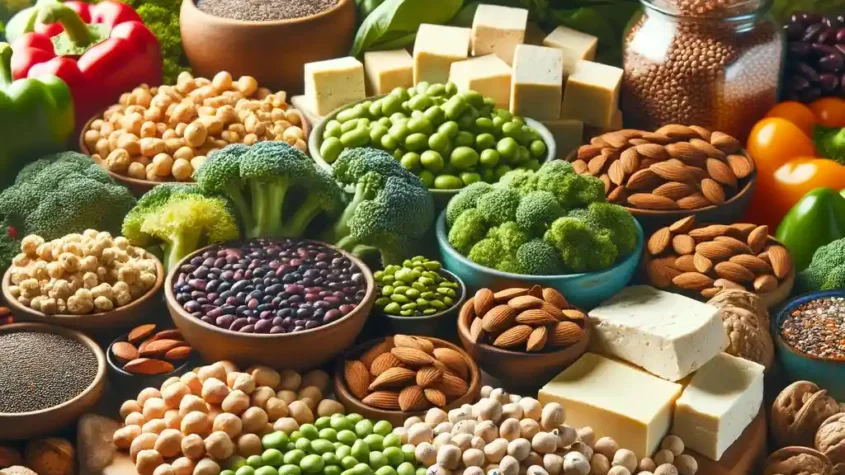
For those seeking nutritious alternatives to animal-based proteins, a variety of vegetarian sources offer substantial benefits. Some of the best vegetarian protein sources include legumes, nuts, seeds, and tofu, all of which can easily fit into a balanced diet. Incorporating these options not only enhances protein intake but also provides essential vitamins and minerals. In this article, we will cover wellhealthorganic.com:vegetarian protein sources
A well-rounded vegetarian diet can support muscle growth, weight management, and overall health. Many individuals may overlook the protein content in foods such as quinoa, lentils, and chickpeas, which can play a crucial role in a vegetarian meal plan. Exploring these sources opens up a range of culinary possibilities for everyone.
Understanding the importance of vegetarian proteins is essential for anyone looking to improve their diet. By highlighting versatile ingredients, this exploration encourages readers to embrace plant-based options that are both satisfying and beneficial.
Exploring Vegetarian Protein Sources
Vegetarian protein sources offer diverse options that can meet dietary needs while providing essential nutrients. This section examines the benefits of plant-based proteins, the distinction between complete and incomplete proteins, and highlights protein-rich vegetarian foods.
Benefits of Plant-Based Proteins
Plant-based proteins come with numerous benefits that can enhance overall health. They tend to be lower in saturated fat and cholesterol compared to animal proteins. This can lead to a reduced risk of heart disease.
Additionally, vegetarian protein sources often contain fiber, which aids in digestion and promotes satiety. Foods such as beans, lentils, and whole grains contribute to a feeling of fullness, which can assist with weight management.
Furthermore, plant-based diets are associated with a lower environmental footprint. Choosing vegetarian proteins supports sustainable agriculture and reduces greenhouse gas emissions.
Complete vs. Incomplete Proteins
Proteins are made up of amino acids, which are categorized as essential or non-essential. Complete proteins contain all nine essential amino acids in sufficient amounts. These are typically found in animal products but can also be derived from specific plant sources.
Incomplete proteins lack one or more essential amino acids. Many plant proteins fall into this category. However, combining different sources can create a complete protein profile. For example, pairing rice and beans offers a balanced amino acid composition suitable for vegetarian diets.
Knowing the difference allows individuals to plan meals effectively, ensuring they receive all necessary nutrients from plant-based sources.
Protein-Rich Vegetarian Foods
Several vegetarian foods are excellent sources of protein. Some notable options include:
- Legumes: Lentils, chickpeas, and black beans offer 15-18 grams of protein per cooked cup.
- Tofu and Tempeh: Tofu contains around 20 grams of protein per cup, while tempeh provides about 31 grams.
- Quinoa: This grain is a complete protein with 8 grams per cooked cup.
- Nuts and Seeds: Almonds and chia seeds pack about 6 grams of protein per ounce.
These options present versatile and nutritious ways to incorporate protein into a vegetarian diet. Combining different foods can help achieve balanced nutrition.
Building a Balanced Vegetarian Diet
Creating a balanced vegetarian diet involves understanding daily protein needs, effectively combining protein sources, and considering supplementation when necessary. These components are vital for maintaining health and ensuring sufficient nutrient intake.
Daily Protein Requirements
Protein needs can vary based on factors like age, sex, activity level, and overall health. For adults, the recommended dietary allowance (RDA) is approximately 46 grams per day for women and 56 grams for men.
Athletes or those engaging in regular intense exercise may require more. They might aim for 1.2 to 2.0 grams of protein per kilogram of body weight. It’s essential to distribute protein intake evenly across meals to maximize absorption and support muscle repair.
Combining Proteins for Maximum Benefit
Vegetarians can optimize their protein intake by combining different sources. Some plant proteins do not contain all essential amino acids, known as incomplete proteins. Mixing them ensures a complete amino acid profile.
Common pairings include:
- Rice and beans
- Peanut butter on whole-grain bread
- Hummus and pita
These combinations can enhance protein quality. Additionally, incorporating a variety of legumes, grains, nuts, and seeds contributes to a well-rounded diet that meets all amino acid requirements.
Supplementing Your Diet with Protein Powders
For some individuals, achieving protein needs through whole foods alone may be challenging. In such cases, protein powders can serve as a convenient supplement.
Options include:
- Whey protein (dairy-based)
- Soy protein (plant-based)
- Pea protein (legume-based)
Selecting a protein powder should focus on individual dietary preferences and potential allergies. It’s advisable to choose products with minimal additives and to be mindful of protein intake from all dietary sources to prevent excessive consumption.
Fitterfirst: Enhancing Your Performance and Stability Through Innovative Solutions
Fitterfirst is an innovative company focused on enhancing physical fitness and overall wel…






